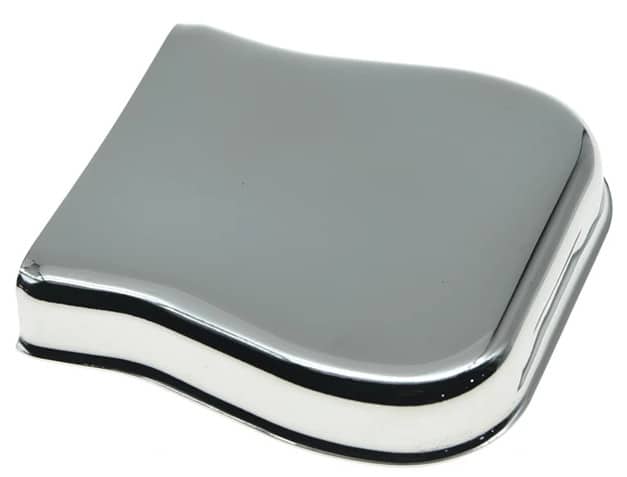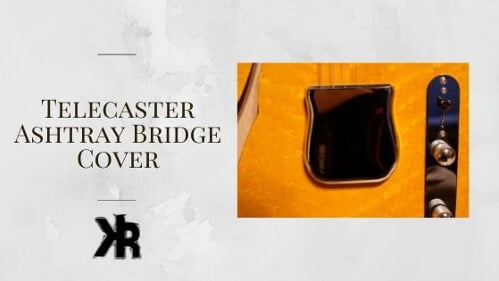Table of Contents
Leo Fender was a master guitar designer and engineer. He took even the very look of his instruments quite seriously. Have you ever seen some older Telecaster or Stratocaster designs? Then you may have noticed a cover over the bridge.
The purpose of the Telecaster guitar bridge cover was not one of pure aesthetics. The cover was applied to increase the magnetic field of the pickup. It provides a thicker, larger sound.
In this Killer Rig article, we will look more into the function and aesthetic of the cover. We’ll see why it is referred to as an ashtray.
Why A Guitar Bridge Cover?
The guitar bridge cover, in this case, it’s also known as an ashtray. It was originally designed for the Telecaster. The idea behind the cover was to create a sleek and finished look for the guitar. All while also increasing the magnetic field around the pickup.
The original Telecaster bridges were quite simple in design. They did not have the smooth lines that we see today.
The covers were added to help give the guitar a more finished and polished look.
The cover also served another purpose. Which was to protect the delicate internals of the bridge from damage. The Telecaster bridge is a complex piece of machinery with many parts.
The cover helped to keep dust, dirt, and other debris from getting into the bridge. Potentially preventing contaminates from causing problems.
What Is a Guitar Ashtray Bridge Cover?
The Telecaster cover is a small, metal plate that is placed over the bridge of the guitar. The purpose of the cover is two-fold. To create a sleek look and to add a thicker sound by increasing the magnetic field around the pickup.
The cover is usually made from chrome or brass and is attached to the guitar with compression.
The bridge cover was originally designed for the Telecaster. But it can be used on any guitar with a similar style. Many people believe that the cover helps to give the guitar a more polished look.

Fender Guitars That Use a Bridge Cover
It’s extremely rare to find these guitars with the original covers still intact. The models that were given covers by Fender were:
- Telecaster
- Stratocaster
- Esquire (single pickup version of the Telecaster)
- Jaguar
- Jazzmaster
- Jazz Bass
As you can see, there are many styles of covers for different models. Some did affect the sound, while others were only there for aesthetics.
Do They Affect Playability?
Guitarists will often ask if the bridge cover affects playability in any way. The answer is yes, and most players immediately removed them from Telecasters as a result.
Today’s guitarist uses palm muting techniques. The cover interferes and prevents proper playability.
With the cover on, the player would have to reposition their hand further up towards the neck.
As a result, the sound and technique are different, which is not worth having the cover on the guitar at all. When Leo Fender created these guitars, the way people played was different. So the covers were not quite as cumbersome.
Yet, if you are a finger picker, the cover might be a benefit to you as it provides a place to anchor your hand.
Do They Affect Sound?
Yes, if you own a Telecaster, the cover can affect the sound when it is installed. It must be made from a material that can be magnetized in order to work.
The idea was that the cover would help increase the magnetic field around the strings. It would possibly present a different sound. And it does!
With it installed, we found that the sound became warmer and more compressed. This is due to a stronger signal when the cover was installed. The result of a redistributed magnetic field.
It isn’t a drastic change, but you can tell that the sound is slightly different.
When it comes to other guitars like the Stratocaster, the sound did not change at all. This is because the cover does not affect the pickups in any way.
Installing a Telecaster Bridge Cover
Have you decided that you would like to add a bridge cover to your electric guitar? Then there are a few things that you need to keep in mind.
First, you need to make sure that your guitar is compatible with the cover.
If you are unsure if your guitar can use one, consult with a professional or take it to a musical instrument shop. The bridge needs to be a vintage design that provides the right sides for the cover to grab onto.
Next, you need to decide what style of cover you would like. As we mentioned, there are many styles and materials to choose from. You can find some made from brass, chrome, or even plastic.
Once you have decided on a style, the next step is to install the cover. This is a relatively simple process, if you have the right bridge, simply snap it into place. It will remain on the guitar with nothing more than compression.
If you do not have the right bridge, then you will need to change it to one that can work with the cover. This will require the help of a professional if you do not feel comfortable making the change.
Conclusion
Adding a Telecaster bridge cover is a personal preference. It does not appeal to everyone in the same way. If you find that it improves the look of your guitar or the sound, then go ahead and install one.
Just make sure that you understand how it will affect the playability of your instrument. Well before making any changes.
FAQs
What do bridge covers do?
On the Telecaster, the bridge cover increases the magnetic field around the strings. This provides a warmer, more compressed sound. On all other guitars, they are there for aesthetics.
What is the ashtray on a Telecaster?
The bridge cover on a Telecaster changed the sound as well as the look of the guitar. Many musicians would remove them and use them as ashtrays for their cigarettes. This is where the name came from.

